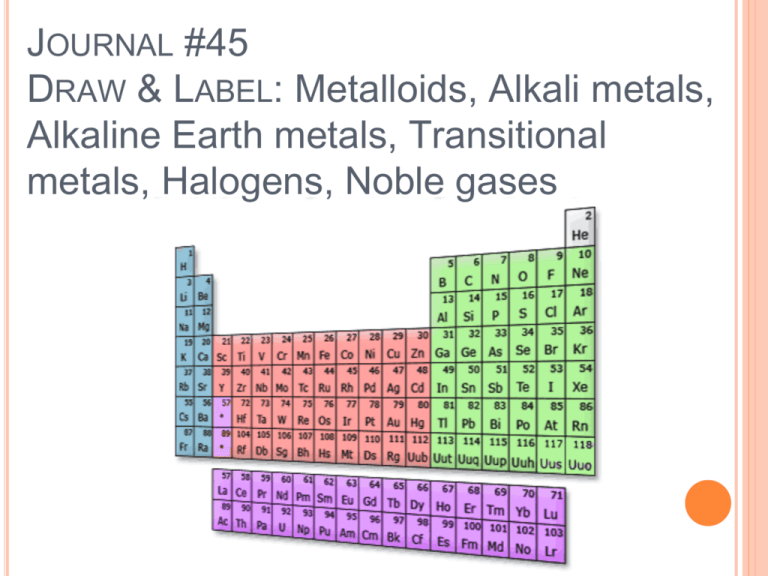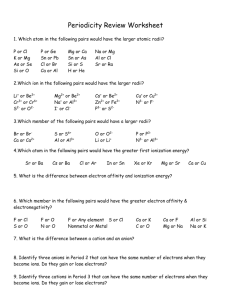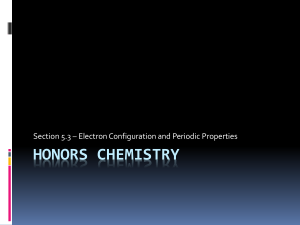File - Mrs. Dawson's Classroom
advertisement

JOURNAL #45 DRAW & LABEL: Metalloids, Alkali metals, Alkaline Earth metals, Transitional metals, Halogens, Noble gases Today we will compare the periodic trends of atomic radii, ionization energy and electronegativity. ATOMIC RADII Atomic radius- one half the distance between the nuclei of identical atoms that are bonded together. ATOMIC RADII Look at figure 13 on pg 151 for atomic radii of the elements. Note that there is a gradual decrease in atomic radii across the period. The trend to smaller atoms across a period is caused by the increasing positive charge of the nucleus. They are gradually pulled closer to the more highly charged nucleus. This increased pull results in a decrease in atomic radii. ATOMIC RADII Atomic radii decrease from left to right across a period and increase down a group. Which of the following elements has the largest atomic radius? Which one has the smallest? Li, O, C or F? Answer: Li, F IONIZATION ENERGY An electron can be removed from an atom if enough energy is supplied. An ion is an atom or group of bonded atoms that has a positive or negative charge. Example: Sodium form an Na+ ion Any process that results in the formation of an ion is referred to as ionization. The energy required to remove one electron from a neutral atom of an element is the ionization energy. IONIZATION ENERGY In general, ionization energies increase across a period and decrease down a group. Ionization energy concerns ONLY the LOSS of electrons. Losing electrons causes an atom to become LESS negative and more positive. IONIZATION ENERGY Group 1 metals have the lowest ionization energies in their respective periods. Therefore they lose electrons most easily. This easy loss of electrons is the major reason for the high reactivity of the group one metals. IONIZATION ENERGY Group 18 elements, the noble gases, have the highest ionization energies. They do not lose electrons easily. The low reactivity of the noble gases is partly based on this difficulty of electron removal. In general, ionization energies of the main-group elements increase across each period. Increase nuclear charge is responsible for both increasing ionization energy and decreasing radii across the periods. IONIZATION ENERGY Among the main-group elements, ionization energies generally decrease down the groups. Electrons removed from atoms of each succeeding element in a group are in higher energy level, father from the nucleus. Therefore, they are removed more easily. IONIZATION ENERGY Removal of one electron is called first ionization energy. The energies for removal of additional electrons from an atom are referred to as the second ionization energy. With sufficient energy, electrons can be removed from positive ions as well as from neutral atoms. ELECTRON AFFINITY Neutral atoms can also acquire electrons. The energy change that occurs when an electron is acquired by a neutral atom is called the atom’s electron affinity. Most atoms release energy when they acquire an electron. ELECTRON AFFINITY On the other hand, some atoms must be forced to gain an electron by the addition of energy. Among the elements of each period, the halogens gain electrons most readily. The ease with which halogen atoms gain electrons is a major reason for the high reactivities of the group 17 elements. ELECTRON AFFINITY Trends for electron affinities within groups are not as regular as trends for ionization energies. As a general rule, electrons add with greater difficulty down a group. Due to slight increase in nuclear charge down a group which increases electron affinities. ELECTRON AFFINITY There are exceptions, especially among the heavy transition metals, which tend to be the same in size or even decrease in radius down a group. It is always more difficult to add a second electron to an already negatively charged ion. IONIC RADII Positive and negative ions have specific names: Cation- a positive ion Formation of a cation is through the loss of one or more electrons. This leads to a decrease in atomic radius. Smaller electron cloud and remaining electrons are drawn closer to nucleus. IONIC RADII Positive and negative ions have specific names: Anion- negative ion Addition of one ore more electrons Increase in atomic radius because the total positive charge of the nucleus remains unchanged when an electron is added to atom. The electron cloud spreads out and has greater repulsion between the increased number of electrons. IONIC RADII Cations are smaller and Anions are bigger than the atoms from which they are formed. YOUR ASSIGNMENT: State the general period and group trends among main-group elements with respect to each of the following properties: Atomic Radii First ionization energy Electron Affinity Ionic Radii On your periodic table, can you guess the properties of your elements?






![The electronic configuration of phosphorus is [Ne] 3s2 3p3](http://s3.studylib.net/store/data/008974852_1-8381577ce936fbfa611892c1a5f109cd-300x300.png)